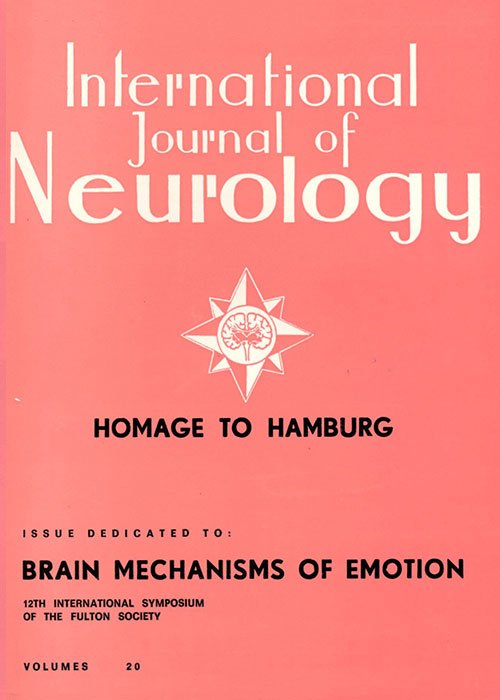Full Issue
DOI:
https://doi.org/10.62486/ijn198640Abstract
The combined issue (Numbers 1–2–3–4) of Volume 20 of the International Journal of Neurology (1986) was dedicated to Brain Mechanisms of Emotion, continuing the exploration initiated in the previous volume but expanding it toward neurochemical, endocrine, and psychophysiological dimensions of emotional behavior. Edited by Víctor Soriano, it reflected the growing interdisciplinary dialogue between neuroscience, psychiatry, endocrinology, and behavioral biology during the mid-1980s.
The issue opened with Robert G. Heath’s influential paper on the neural substrate for emotion, which examined the interrelation of feeling, sensory perception, and memory, emphasizing limbic–cortical integration as the biological basis of subjective emotional experience. Bengt J. Meyerson and Urban Höglund investigated neuropeptides and social behavior, proposing that neurochemical modulation—particularly through peptides—mediates environmental and social influences on affective behavior.
Murray Glusman contributed an extensive experimental analysis of aggressive behavior in cats, identifying neural circuits in the hypothalamus and midbrain responsible for the initiation and control of aggression. Ralph Spintge introduced an innovative line of research on the neuroendocrinological effects of so-called anxiolytic music, demonstrating how auditory stimuli could influence hormonal responses and emotional states, linking art, physiology, and therapy.
Carlo L. Cazzullo and C. Masserini examined the bidirectional relationship between emotion and immunity, a precursor to modern psychoneuroimmunology, while Janice Stevens and Lawrence L. Levy presented clinical observations on limbic dysfunction in acute psychoses in Zimbabwe, illustrating cross-cultural neuropsychiatric patterns.
Michael R. Trimble explored the physiological link between epilepsy and psychosis, discussing shared limbic substrates and neurotransmitter disturbances that blur traditional distinctions between neurological and psychiatric disorders. Klaus D. Döhler offered a developmental perspective with a study on hormonal regulation of the sexually dimorphic nucleus in the preoptic area of the rat brain, emphasizing endocrine control of neural differentiation and behavioral sexual dimorphism.
A remarkable clinical contribution came from Upton, Cooper, Springman, and Amin, who reported the suppression of seizures and psychosis of limbic origin by chronic stimulation of the anterior thalamic nucleus, pioneering an early form of what would later evolve into deep brain stimulation (DBS).
The issue closed with a History of Medicine note by Ralph Spintge, Soriano’s travel reflection “On Vacation – Homage to Hamburg,” and the traditional news and book review sections.
This volume represented a decisive step toward a neurobiological synthesis of emotion, integrating electrophysiology, endocrinology, and clinical neurology to portray emotion as a dynamic network phenomenon encompassing brain, body, and behavior.
Downloads
Published
Issue
Section
License
Copyright (c) 1986 International Journal of Neurology (Author)

This work is licensed under a Creative Commons Attribution 4.0 International License.
The article is distributed under the Creative Commons Attribution 4.0 License. Unless otherwise stated, associated published material is distributed under the same licence.







